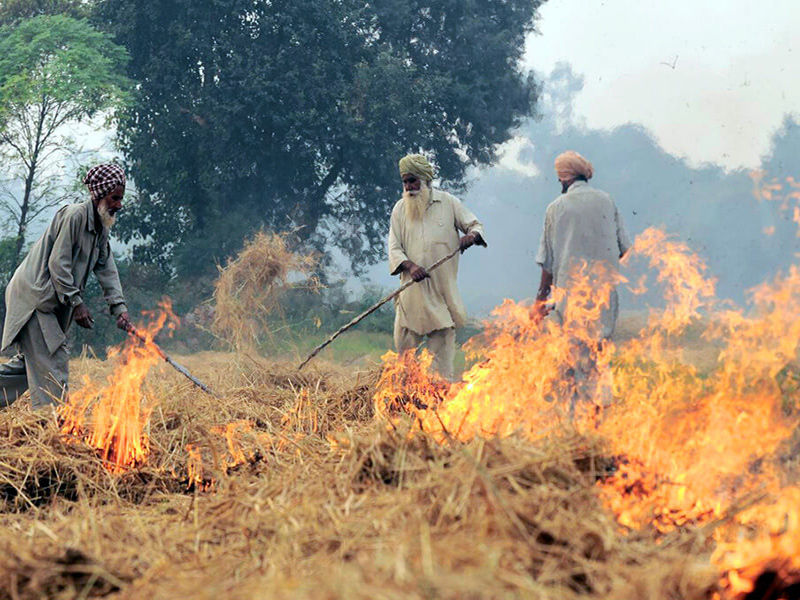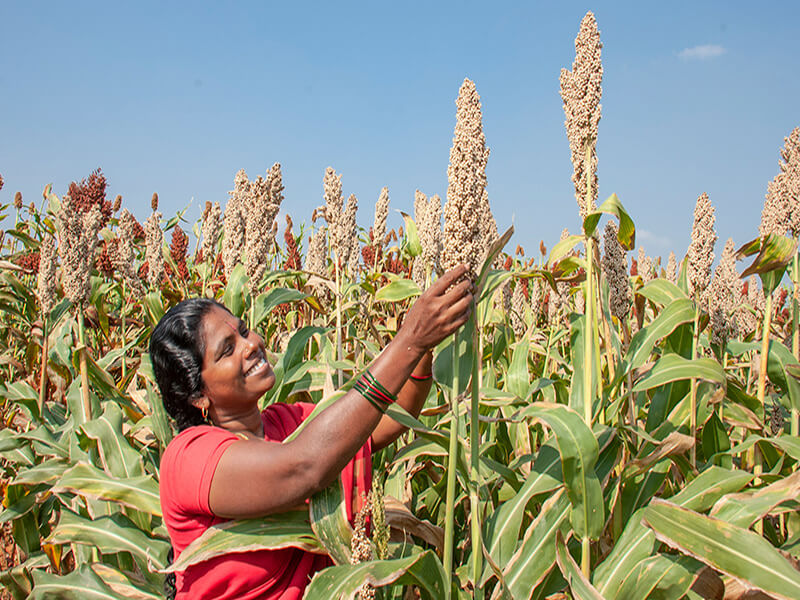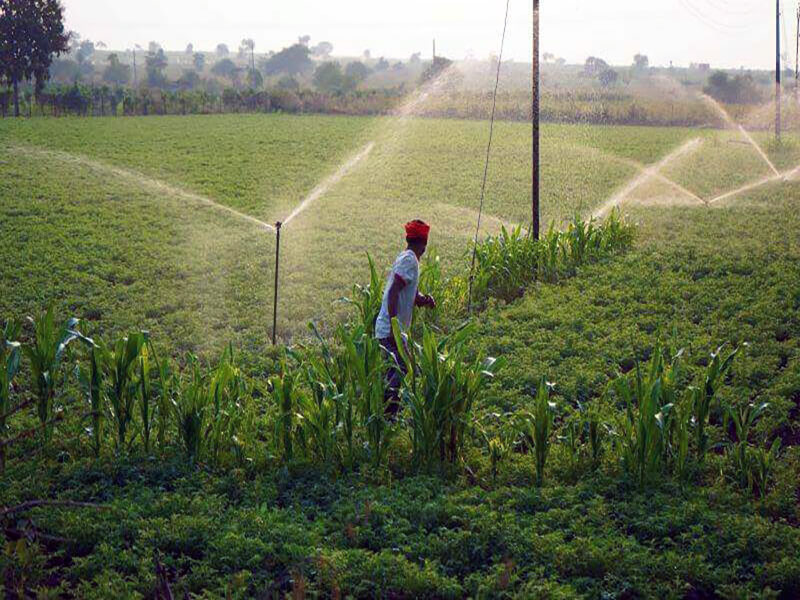The 500-odd farmers of Gurha Kumawatan, a village in arid Rajasthan, are now millionaires thanks to polyhouse farming. Their hard work, innovation and unlimited ambition offers a path to prosperity for others in India.
‘While promoting rainfed and sustainable agriculture, lessons from the Green Revolution have to be kept in mind and rigorously followed’
 Aarthi Ramachandran
Aarthi Ramachandran 
The Green Revolution was a landmark event in the 1960s and 1970s through which Independent India was able to grow enough food to feed its citizens for the first time. By adopting high-yielding varieties, extensive use of fertilisers, pesticides and new irrigation methods, India was able to dramatically increase its food production from 72 million tonnes in 1965 to nearly 325 million tonnes in 2023.
Since the Green Revolution, the practices it promoted have become the norm in Indian agriculture. At the same time, this resource and chemical intensive agriculture has created several problems such as depleting soil health and groundwater. The excessive focus on rice and wheat resulted in the neglect of nutritionally and economically important crops such as millets, pulses and oilseeds.
The Plate’s Aarthi Ramachandran spoke with PS Vijayshankar, an expert in sustainable agriculture and water resource management, to understand the historical background of the Green Revolution, its consequences and current-day reassessments.
Vijayshankar is a co-founder of Samaj Pragati Sahayog, an NGO based in Madhya Pradesh. He has spent close to three decades working with adivasi communities in the Narmada valley, and written extensively on issues related to farming in rainfed regions. He was a member of the Planning Commission’s working groups and part of the Steering Committee for the Integrated Watershed Management Programme of the Rural Development Ministry from 2009 to 2014.
In the 1960s there was a genuine problem of food shortage in India. We sometimes tend to forget history. In 1943, there was the big Bengal famine. An estimated three million people died. During the Partition in 1947, there was a huge influx of refugees from Pakistan. These were the emergencies the newly formed national government had to address. It was also the cold war era, with growing tensions between the US and the Soviet Union. Then skirmishes with Pakistan: a limited war in 1948 and another full-fledged war in 1965; the war with China in 1962. It was a very turbulent period.
So the policy makers really thought that if they didn’t do something, the Bengal famine might repeat. Between 1950 and 1960, food production did grow significantly at 2.6% annually. However, the wars and back-to-back droughts towards the middle of 1960s disrupted the process. India received a lot of advice from US non-governmental aid organisations Rockefeller Foundation and Ford Foundation, who may have had an agenda, but that agenda had a resonance in the national conscience. It’s a very complex picture. So one-sided stories saying it was an imperialist conspiracy, or a great success of nationalist impulse are both a bit wonky and incorrect. Truth is somewhere in the middle, as always.

Those are important things. Rather than seeing the Green Revolution as an event, I would see it as a process; a way of doing agriculture. The whole set of institutions that we now associate with the Green Revolution did not all come up all at once. Along with the Green Revolution, fertiliser and pesticide companies were encouraged and capacity for domestic production was created. Many new agriculture universities were created for research on crops. Krishi Vigyaan Kendras (KVKs) were set up. Most importantly, the public extension system, that took the modern inputs – fertilizers, seeds and pesticides – to the farmers, was put in place. The Food Corporation of India (FCI) was established earlier but became a strong organisation, engaged in public procurement, later. Bank nationalisation in 1969 led to opening of many more rural branches. The whole architecture came together by the mid-1970s, and has become the primary means of bringing about agricultural transformation in India.

It depends on how you look at it. If you think of it as an event that happened in the mid-1960s, then it was mostly confined to the northwest and southern parts of India. If you look at it as a way of doing agriculture, as a process, then what happened in the mid-1960s triggered a chain of events that established a high-input model. That model continued and was taken to different places and introduced to different cropping systems over a period of time.
However, there have been real physical constraints to the expansion of the green revolution approach, because water is important for many of these technologies. In 65% of India, which is underlain by hard rocks, water access is difficult. In such places the technologies introduced by the Green Revolution will not work easily. Therefore, we must be open to incorporating local variations and innovations, including those practised by farming communities.

You mentioned MS Swaminathan’s observation that the Green Revolution was confined to northwest India and a few other places. But that was not an accident, it was a choice. The technology that they chose, hybrid technology in terms of seeds, fertilisers and choice of crop, needed water. They could do it only in places where assured water was available. The crops chosen were also limited – basically rice and wheat.
Today we are saying the productivity of other crops, such as millets, is low. But is low productivity a function of lack of investment? If you had focussed on pulses or millets and invested an equal amount of time and energy in them, they too would have seen crop system improvements.

People were not aware of the ecological consequences of the Green Revolution earlier. Now there is an understanding that if you put too much fertiliser into the soil, soil quality is degraded. Too much groundwater extraction leads to the depletion of water levels. If you focus on only one crop, crop diversity and hence biodiversity goes down. Excessive use of what the Food and Agriculture Organisation has called “highly hazardous substances” (HHS), like chemical pesticides, threaten the safety of the entire food system.
So the criticism of the Green Revolution today is from an ecological point of view. Of its ‘extractive perspective’ or where natural resources are seen as primarily for extraction and use by humans. Opposite to that, there is an ecosystem perspective that emphasises conservation and recycling of natural resources. The ecosystem approach considers the economy as part of the larger whole. So if we applied that approach we could ask, why is Punjab growing rice even though the state’s ecosystem is not suited for it?
Sustainable approaches to agricultural development are urgently needed. I am part of an institution that promotes non-pesticide management (NPM) agriculture. The mission of this organisation, called Nature Positive Foundation, is to eliminate the use of chemical pesticides, weedicides and fungicides in our farming and food systems. I think this is a very practical and scalable option.

The government is saying a lot, but there is a lot of difference between what the government says and what the government does. To take one recent example, there were strong recommendations from at least two government committees for banning the production and use of 27 highly hazardous chemical pesticides. However, the government still has not passed orders for effecting this ban. In fact, there are moves to dilute this ban arbitrarily to just three chemical pesticides. They were speaking about a National Mission on Natural Farming with a budget of 1,500 crores. Compared to that they have allocated roughly two lakh crores to fertilisers. That is the kind of disproportionality we are speaking of.
Sustainable agriculture has many forms in India today, including organic and natural farming. Yet this is not practised in more than two or three per cent of the total net sown area which is 140 million hectares. The same holds true for the percentage of farmers engaged in alternative farming.
Why are these initiatives not getting scaled up? There seems to be some problem. I believe that more scalable options like NPM agriculture are available that are focused on the elimination of highly hazardous substances from our food system. Getting farmers to move away from all agri-chemicals is going to take a long time.
The general understanding is that any alternative to conventional high-input agriculture will necessarily result in a yield drop. However, there are two studies by the Centre for Science and Environment (CSE), New Delhi, where they used the government’s own data on organic farming and showed that there is no yield drop. In some crops there was a yield increase. There is no reason for any yield loss in the case of NPM or nature positive agriculture if crop pests are managed without chemical pesticides.
Then there is also a knowledge gap. The agriculture research system is focussed on the Green Revolution’s high-input model of more fertilisers and other inputs. That has seeped into their psyche. There is also a clear lack of investment support for alternative models. Government has to invest more money in all these alternatives.
That is when we have to look at lessons from the Green Revolution. There are three things I find very important in the Green Revolution. One, it was very focussed. Whether good or bad, one can make an assessment of that, but they did not try to do the Green Revolution everywhere in India. It was a targeted programme.
Secondly, they did not do only one thing. They provided seeds, they provided fertilisers, and water was already there. Then banks were nationalised in 1969. They were asked to go to the villages and lend to the poor. A lot of money came from the banks with a low rate of interest. Farmers were able to make use of that.
Then, thirdly, they brought about policy changes such as the Minimum Support Price (MSP) and procurement by the FCI so farmers had an assured price and seller for their produce. It was a complete package backed by huge public investment and sustained over a period of time.
While promoting rainfed and sustainable agriculture, these principles have to be kept in mind and rigorously followed. Such an effort has not yet been attempted.
The 500-odd farmers of Gurha Kumawatan, a village in arid Rajasthan, are now millionaires thanks to polyhouse farming. Their hard work, innovation and unlimited ambition offers a path to prosperity for others in India.